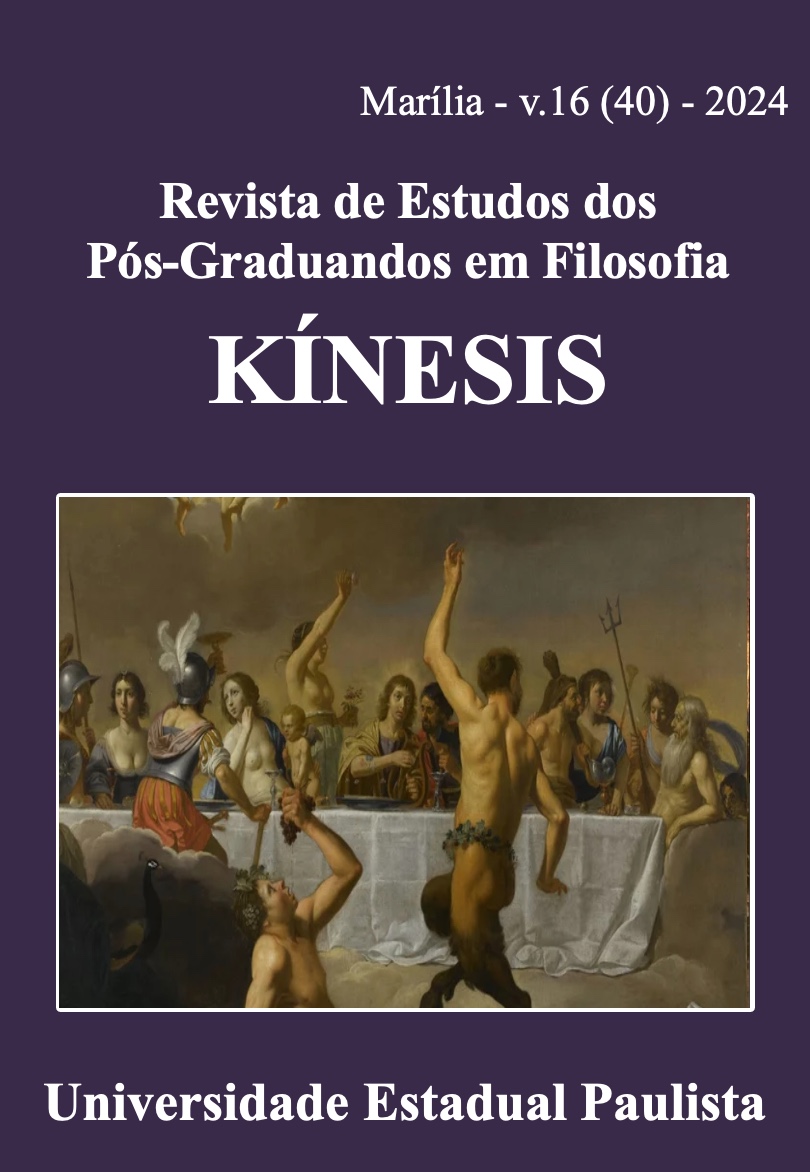LINGUAGEM, INTENCIONALIDADE E O PROBLEMA DA INTELIGÊNCIA ARTIFICIAL
DOI:
https://doi.org/10.36311/1984-8900.2024.v16n40.p310-323Palavras-chave:
Intencionalidade, John Searle, Inteligência Artificial, Atos de FalaResumo
Esse trabalho pretende entender quais mecanismos da linguagem revelam a intencionalidade, analisando o trabalho de John Searle. Após a exposição de parte da teoria de Searle sobre a intencionalidade, será feito um comentário a respeito dos recentes avanços da Inteligência Artificial, em especial àquelas ferramentas que lidam com a linguagem natural. Por fim, explicaremos por que, por mais sofisticados que sejam, essas ferramentas estão longe de apresentar algum tipo de intencionalidade aos moldes da teoria de Searle.
Downloads
Referências
AUSTIN, J. L. Philosophical Papers. Oxford University Press, 1979.
ANSCOMBE, Elizabeth. Intention. Harvard University Press, 2000.
BENDER, Emily M.; KOLLER, Alexander. On Meaning, Form, and Understanding in the Age of Data. Proceedings of the 58th Annual Meeting of the Association for Computational Linguistics, p. 5185–5198, 2020.
CLARK, Stephen. Vector space models of lexical meaning. In: LAPIN, Shalom; FOX, Chris (Eds.). Handbook of Contemporary Semantic Theory, 2nd edition. Wiley-Blackwell, 2015.
DAVIDSON, Donald. A Nice Derangement of Epitaphs. In: GRANDY, Richard E.; WARNER, Richard (Eds.). Philosophical Grounds of Rationality. Clarendon Press, 1986.
DRETSKE, Fred. The Intentionality of Perception. In: SMITH, Barry. John Searle. Cambridge University Press, 2003.
DZIRI, Nouha; MILTON, Sivan; YU, Mo; ZAINE, Osmar; REDDY, Siva. On the Origin of Hallucinations in Conversational Models: Is it the Datasets or the Models? In: Proceedings of the 2022 Conference of the North American Chapter of the Association for Computational Linguistics: Human Language Technologies, p. 5271 – 5285, 2022.
GRICE, Paul H. Utterer’s Meaning, Sentence Meaning, and Word-Meaning. In: KULAS, Jack; FETZER, James H.; RANKIN, Terry L.; Philosophy, Language and Artificial Intelligence. Kluwer Academic Publishers, 1988.
JURAFSKY, Dan; MARTIN, James H.; Speech and Language Processing: An Introduction to Natural Language Processing, Computational Linguistics, and Speech Recognition. Pearson Prentice Hall, 2009.
LAFFERTY, John; ZHAI, Cheng Xiang; CROFT, W. Bruce. Language Modeling for Information Retrieval. Springer, 2020.
LEVINSON, Stephen C. Pragmatics. Cambridge University Press, 1983.
RUSSELL, Stuart; NORVIG, Peter. Artificial Intelligence, A Modern Approach. 4th Edition. Pearson, 2020.
SEARLE, John R. Speech Acts. Cambridge University Press, 1969.
SEARLE, John R. Minds, Brains, and Programs. Behavioral Brain Sciences, 1980a.
SEARLE, John R. Intentionality. Cambridge University Press, 1983.
SEARLE, John R. Consciousness and Language. Cambridge University Press, 1995.
SEARLE, John R. The Mystery of Consciousness. Cambridge University Press, 1992.
SEARLE, John R. The Construction of Social Reality. Free Press, 1995. Shannon, Claude Elwood. Prediction and entropy of printed English. Bell System Technical Journal, Vol. 30, p. 51-64, 1951.
SMITH, Barry. John Searle. Cambridge University Press, 2003.
ZAIBERT, Leo. Intentions, Promises, and Obligations. In: SMITH, Barry. John Searle. Cambridge University Press, 2003.
PENCO, Carlo. Introdução a Filosofia da Linguagem. Editora Vozes, 2006.
TIKU, Nitasha. "The Google engineer who thinks the company's AI has come to life". The Washington Post, June 11, 2022. ISSN 0190-8286. Disponível em: https://www.washingtonpost.com/technology/2022/06/11/google-ai-lamda-blakelemoine/. Acesso em: 12 de junho de 2022.
TUNG, Liam. "ChatGPT can write code. Now researchers say it's good at fixing bugs, too". ZDNET, January 26, 2023. Disponível em: https://www.zdnet.com/article/chatgpt-can-write-code-now-researchers-say-its-goodat-
fixing-bugs-too/. Acesso em: 30 de janeiro de 2023.
WEIZENBAUM, Joseph. "ELIZA—a computer program for the study of natural language communication between man and machine". Communications of the ACM, 9, 1966, p. 36–45. doi:10.1145/365153.365168. S2CID 1896290.
WINOGRAD, Terry. "Procedures as a Representation for Data in a Computer Program for Understanding Natural Language". https://dspace.mit.edu/handle/1721.1/7095. Acesso em: [Junho de 2023].
What’s the next word in large language models? Nat Mach Intell 5, 331–332 (2023). https://doi.org/10.1038/s42256-023-00655-z
What’s the next word in large language models?. Nat Mach Intell 5, 331–332 (2023). https://doi.org/10.1038/s42256-023-00655-z.
Downloads
Publicado
Edição
Seção
Licença
Copyright (c) 2024 Kínesis - Revista de Estudos dos Pós-Graduandos em Filosofia

Este trabalho está licenciado sob uma licença Creative Commons Attribution-NonCommercial-ShareAlike 4.0 International License.





